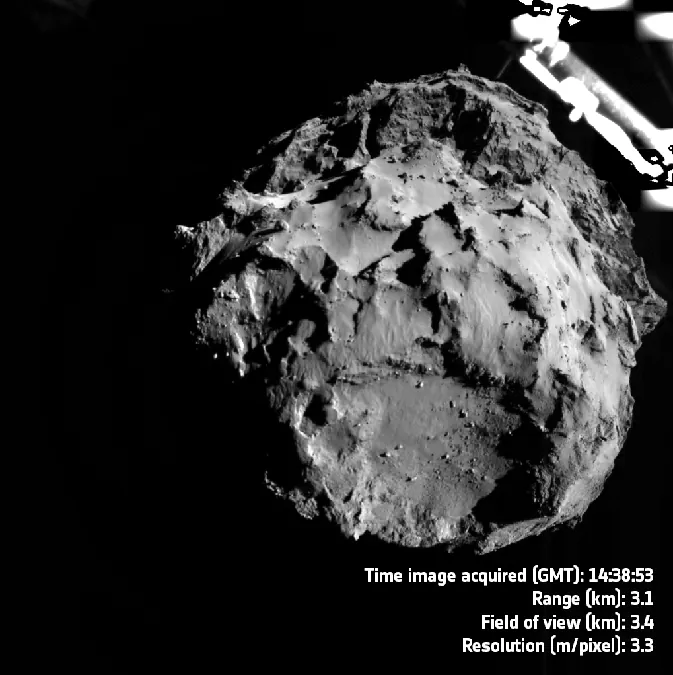
Mini-Miracle in Space: The Epic 2014 Comet Landing of Philae Remembered!
2024-11-12
Author: Jacob
A Race Against Time: Finding the Perfect Spot
Rosetta's journey to the comet was both thrilling and tense. Upon arriving on August 6, 2014, mission teams had to swiftly identify a safe landing location. The ideal site would balance safety with scientific opportunities. After extensive analysis of various potential landing areas captured in images, the smooth patch known as Agilkia was selected on the smaller lobe of the comet.
However, the night before the landing, engineers encountered a significant hurdle: Philae's descent system, which was designed to control the lander’s touchdown, was malfunctioning. With no time to lose, the team decided to proceed relying on harpoons and ice screws in Philae's legs to secure it to the comet’s surface.
Touchdown: A Historic Moment in Space Exploration
As Philae began its seven-hour descent, it engaged its sensors to gather information about the comet's environment. When it finally touched down at Agilkia, the first vibrations from a human-made object contacting a comet were recorded, marking a monumental moment in scientific history. However, it was soon realized that the harpoons hadn’t fired as intended, causing Philae to bounce off the surface.
Remarkably, Philae made contact with the comet not once but four times during its descent! Each bounce allowed the lander to collect invaluable data from different locations on the comet, offering insights into its surface characteristics that would have otherwise been impossible.
For instance, during its bounces, Philae discovered a soft layer of ice several centimeters deep, as well as a much harder crust underneath. In one of its journeys, it even recorded the first in situ measurement of a boulder's softness, revealing a porosity of about 75%, akin to the fluffiness of cappuccino froth.
A Multitude of Discoveries
Philae continued to surprise scientists with its groundbreaking discoveries. With its MUPUS hammer, it penetrated soft layers of the comet, uncovering temperature variations within the extreme range of -180°C to 145°C, providing insights into the temperature cycle of the comet.
Perhaps most excitingly, the COSAC instrument detected 16 unique organic compounds, some of which had never been seen in comets before. These findings have major implications for our understanding of the origins of life on Earth, suggesting that comets could be rich sources of the building blocks for life.
Additionally, Philae was able to measure the magnetic field near the comet's surface. This was unprecedented since previous missions struggled to gather comparable data due to their high-velocity passes. The close proximity allowed for a detailed examination, adding another layer to our understanding of comets.
Philae’s Remarkable Legacy and the Road Ahead
Despite falling into hibernation after its initial operations, Philae had already achieved about 80% of its scientific goals. During Philae's dormancy, the Rosetta orbiter continued to gather comprehensive data, observing the comet's behavior as it neared the Sun.
In a thrilling twist of fate, Philae's final resting location was revealed just before the Rosetta mission concluded with its own dramatic landing on the comet, further cementing the legacy of both spacecraft.
Moving forward, ESA's spirit of innovation continues with upcoming missions like Comet Interceptor, designed to explore a pristine comet entering our Solar System for the first time. This mission will analyze unaltered materials from the early Solar System, allowing scientists to piece together the origins of the celestial bodies around us.
Additionally, ESA's Hera mission will dive deeper into planetary defense techniques by surveying the asteroid Dimorphos, an essential step in safeguarding Earth against potential asteroid impacts.
As we look back on Philae's historic achievements, interest in space exploration continues to rise, inspiring a new generation of scientists and students keen on unraveling the mysteries of our universe. Join us in reliving this remarkable journey on social media, using the hashtag #CometLandingRelived, and celebrate humanity's relentless quest to explore the cosmos!









 Brasil (PT)
Brasil (PT)
 Canada (EN)
Canada (EN)
 Chile (ES)
Chile (ES)
 España (ES)
España (ES)
 France (FR)
France (FR)
 Hong Kong (EN)
Hong Kong (EN)
 Italia (IT)
Italia (IT)
 日本 (JA)
日本 (JA)
 Magyarország (HU)
Magyarország (HU)
 Norge (NO)
Norge (NO)
 Polska (PL)
Polska (PL)
 Schweiz (DE)
Schweiz (DE)
 Singapore (EN)
Singapore (EN)
 Sverige (SV)
Sverige (SV)
 Suomi (FI)
Suomi (FI)
 Türkiye (TR)
Türkiye (TR)